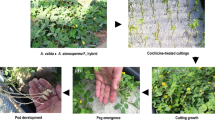Abstract
A synthetic hexaploid oat was produced by chromosome doubling of a sterile triploid hybrid between cultivated Avena strigosa (2n = 14) cv. Saia and a domesticated form of A. magna (2n = 28). The synthetic hexaploid was intermediate between its parents in panicle shape and lemma color, similar to the tetraploid parent in spikelet structure, and to the diploid parent in having a single, albeit partially shriveled seed per spikelet, and low protein content. By the third generation, plants with yellowish lemmas, mostly two seeds per spikelet and better filled grains had been selected. Rust resistance of the diploid parent was retained in the synthetic hexaploid, but not tolerance to barley yellow dwarf virus disease (BYDV). Chromosome associations at meiosis in the triploid hybrid was low, with over 60% of them being univalents. Bivalent association was the rule in the synthetic hexaploid with an occasional one or two quadrivalents. Regular meiosis with 21 bivalents was observed in further generations. The preferential pairing of homologous chromosomes in the synthetic hexaploid was probably contributed by the A. strigosa genome which exhibits this tendency in artificial allopolyploid situations. Selection of yellow lemma color and two seeds per spikelet suggests that the genes controlling these traits are located on the chromosomes involved in quadrivalents in the synthetic hexaploid. The potential and limitations of utilizing the synthetic hexaploid in oat research and breeding are briefly discussed.
Similar content being viewed by others
References
Bennett, M.D., 1977. Heterochromatin, aberrant endosperm nuclei and grain shriveling in wheat-rye genotypes. Heredity 39: 411-419.
Ladizinsky, G., 1974. Genome relationships in diploid oats. Chromosoma 47: 109-117.
Ladizinsky, G., 1995. Domestication via hybridization of the wild tetraploid oats Avena magna and A. murphyi. Theor Appl Genet 91: 639-646.
Ladizinsky, G., 1998a. A new species of oat from Sicily, possibly the tetraploid progenitor of hexaploid oats. Genet Resou Crop Evol 45: 263-269.
Ladizinsky, G., 1998b. Plant Evolution Under Domestication. Kluwer Acad Pub, Dordrecht.
Marshall, H.G. & G.E. Shaner, 1992. Genetics and inheritance in oats. In: H.G. Marshall & M.E. Sorrells (Eds.), Oat Science and Technology, pp. 509-571. Amer Soc Agron, Madison.
Author information
Authors and Affiliations
Rights and permissions
About this article
Cite this article
Ladizinsky, G. A synthetic hexaploid (2n = 42) oat from the cross of Avena strigosa (2n = 14) and domesticated A. magna (2n = 28). Euphytica 116, 231–235 (2000). https://doi.org/10.1023/A:1004056315278
Issue Date:
DOI: https://doi.org/10.1023/A:1004056315278




